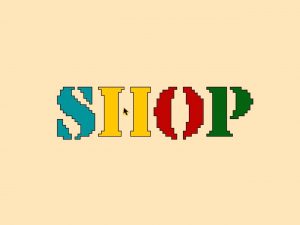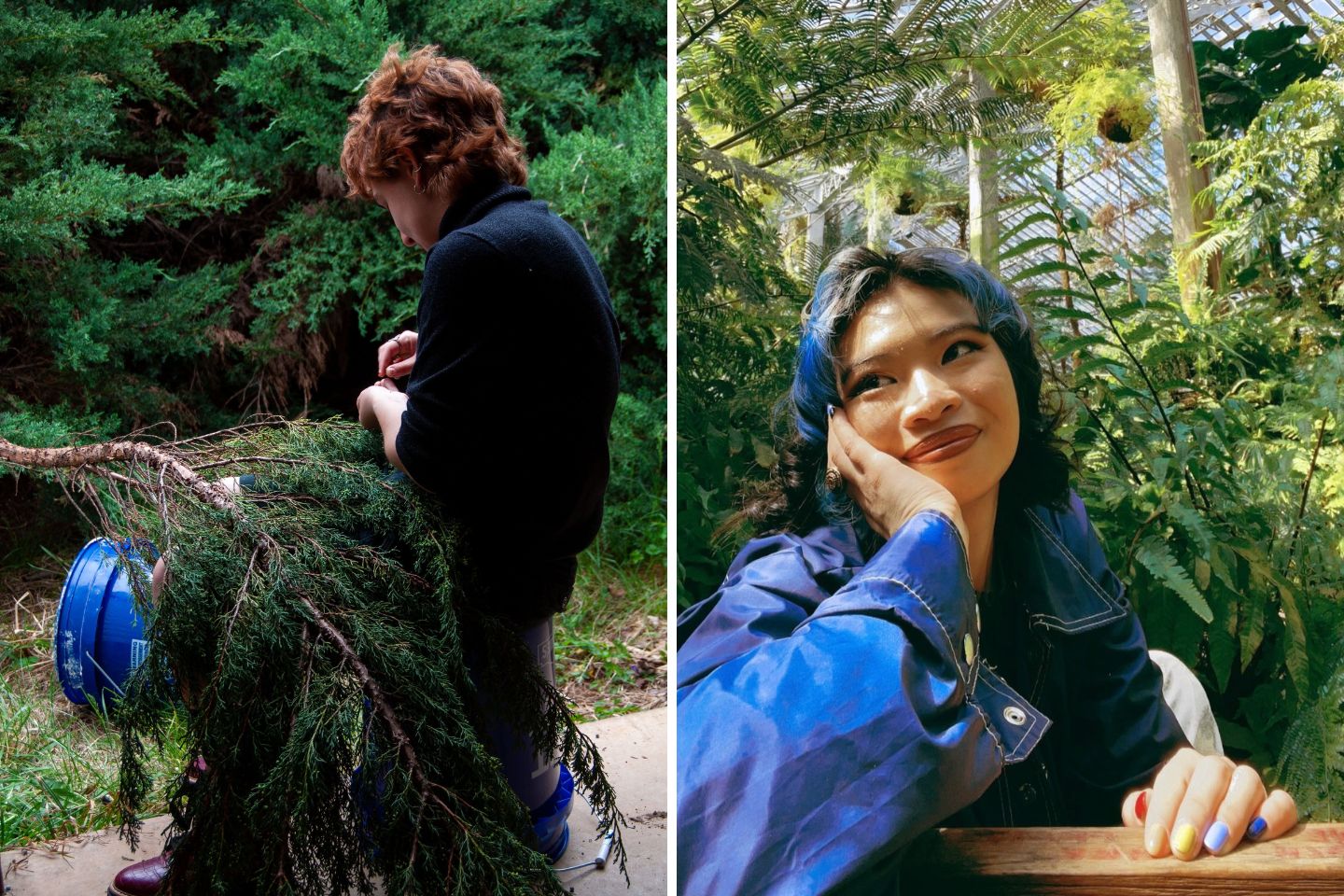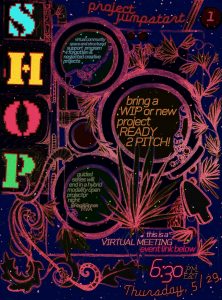
Since graduating, Kinetic Imaging Alumnae, Marie Anderson (B.F.A. ’23) and Rayna Hugo (B.F.A. ’23) have been cultivating a community to stay connected. Introducing SHOP, a new virtual home for interdisciplinary artists, makers, and organizers to self-educate, support, and connect with each other online and in the wild, created by Marie and Rayna. In this interview with Narrative Media Administrative Affairs Coordinator, Taylor Colimore, and undergraduate student communications assistant, Nicole Strauss, Marie and Rayna share how this community came to be.

How are you both keeping in tune with your artwork post grad? And how do you stay motivated to continue making art after graduating?
Rayna Hugo: You’re trying to find an avenue where you can capitalize on your obsessions, and that could mean so many things over a single lifetime. I wanted nothing more than the freedom to make things. The truth is, keeping in tune with my artwork was not a priority, being able to afford to was. I took a beat, and just tried to unravel who I was outside of academia. It’s good to have an art practice that rejuvenates you in the process. For me, I discovered myself again in low-tech forms of expression like writing, sketching, and collaging. Once in a while, you’ll get an idea that clings to you and you don’t know how to do it, and guess what, you’re a student of that idea now. I think it’s important to remember that your creativity is always accessible to you when the time comes.
Marie Anderson: Poorly and sporadically! I get good breaks when I’m making work for a something or a someone (other than myself). Making art for a void can feel herculean. I need to tell people to tell me what to do to get work done. If someone is looking for advice from the other end of a lot of trial and error, it would be to make sure you have venues, clients, and final destinations set up for yourself and your work. This is something that is hand fed to you in school, but it can make all the difference between being able to imagine your work as a realized product and staying something that exists only in a notebook.
What are some factors that have contributed to the evolution of your work and skills over time?
RH: Community. I don’t underestimate the power of influences. What better way to get inspired than to surround yourself with new and usual perspectives? Bounce ideas. Get jealous. I can feel like I’m missing out on creativity or skills so I can work on not having to.
MA: Time to think. I’ve had so much of it to soak in all of my old work and let what didn’t feel true to my worldview and passions dissolve away. I have a very clear idea of the imagery, patterns, themes that define my work now.
Do your skills and experiences in other disciplines influence your work in Kinetic Imaging in any way?
RH: I came to VCUarts thinking I would be an editorial photographer, and left with calling myself an AudioVisual Media artist. A year in Photography + Film helped me with tech, composition, and editing. Creative writing laid a blueprint for me for storytelling performances. Playing instruments led me to the sound design minor. My other media-studies minor emphasized graphic design and journalism. Over my time in Kinetic Imaging, I was either thinking of escapism or performance. Living in fantastical daydreams contrasted with being as present as possible.
MA: I’m working as a professional horticulturist! I think that spending time being creative with natural and variable things has been teaching me to be slower, kinder, and more adaptable with my ideas. An art practice is a garden. It takes nourishment, pruning, and well-researched care. It has its seasons, and it can take a long time to become grown in.
How did the server come to be?
RH: Right as our last semester was wrapping up, I had a conversation with Kinetic Imaging Professor Kate Sicchio about the creative technology community and how it feels unintegrated into the city of Richmond compared to others. I asked how to find community, and Kate mentioned how Live Code NYC started out as a few people meeting at her kitchen table. Maybe it’s not necessarily about finding community. Maybe it has to be fostered. Maybe the person to organize that could be me. I felt like my peers were a good start. So I created a discord where we can keep in touch post grad. Marie was especially onboard with the idea, and organically became a crucial element of administering the server and our meetings.
MA: Rayna brought our KI23 server together! And it had been long enough after graduation that I think everyone was really curious about where we all ended up.
SHOP has been a longer road. It has been on both of our minds in some way or another since the Fall after we graduated. I think it rooted over coffee as a want to skillshare and swap art inspirations. I started making attempts to pull something together that Winter, having started to feel the strain of making art totally isolated from any creative hubs or cultural centers.
Rayna and I have been meeting for a few months now to give things form. Something in the past year changed in my mind that made it feel less like a, “I wish someone else would do this” or pipedream thing, and more like a “this is so simple, why wouldn’t we be able to do it,” kind of thing. We got our B.F.A.’s at the height of the pandemic! I don’t think anyone could be better qualified to organize a virtual collective.
What has been the impact from engaging on the server?
RH: It situated a shared perspective. No one was where they thought they would be, but adapting and talking through our art practices made it clear that we were where we were meant to be.
MA: The KI23 server was a lot of catching up on each others’ professional lives and art practices. We got to see folks share little pieces of their postgrad art practice that goes on behind the scenes and out of social media– concept development, little projects, and things folks wished that they had more time to do. I would encourage any graduating year and major department to set something similar up for themselves.
There’s no way to tell what SHOP’s impact will be from here, but here’s to hoping its framework will be actionable and intentional enough to give birth to new projects, make a bridge between strangers, and bring ideas out of the chatroom to in-person venues.
Have there been any creative collaborations on the server?
RH: Yes! It’s always good to see people exchanging info for a variety of projects.
MA: Folks have definitely reached out to the KI23 server when they’ve been looking for new team members for their large-scale projects! And we’ve swapped a few gig offers.
I am hoping that SHOP itself will be a collaborative work.
How have you both been able to inspire one another?
RH: Marie and I have the same buzzwords for what strike us to our core, but completely different executions. With collaboration, I don’t want an echochamber. I want perspective. Being able to have a portal open to Marie’s fantastical world is a dear privilege.
MA: Rayna has the most insane and beautiful ideas. We will make powerpoints and mood boards to share projects that have been brewing in the back of our minds. Keeping in touch with another artist who thinks in great complexity and scale and feeds repeating imagery in their work over a long period of time makes me a braver and better artist.
I definitely want to set the mood of SHOP like this– wild ideas you want to see in the world and an equally wild group of people behind you pushing you halfway to the finish line.

Marie and Rayna will be kicking off the first meeting of their PROJECT JUMPSTART series, where you can pitch a new idea or a project you need to put into motion. Come with your project ready-to-pitch! You’ll be able to jump into this series at any time if you miss the first meeting.
Thursday, May 29th
6:30 – 8:00 pm
Virtual (Link TBA)